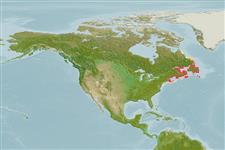Classificação / Names
Common names from other countries
Referência principal
Tamanho / Peso / Idade
Max length : 86.0 cm SL macho/indeterminado; (Ref. 7248); common length : 26.4 cm TL macho/indeterminado; (Ref. 12193); Peso máx. publicado: 8.0 kg (Ref. 100229); Idade máx. registada: 24 anos (Ref. 72501)
Ambiente
; marinhas; Água doce; estuarina bentopelágico; anádromos (Ref. 51243); intervalo de profundidade 15 - 27 m (Ref. 3899)
Clima / Intervalo
Temperate; ? - 25°C (Ref. 35682), preferred ?; 65°N - 30°N, 95°W - 52°W
Distribuição
North America: native to most of eastern Canada from Newfoundland and Labrador to western side of Hudson Bay; south in Atlantic, Great Lakes, and Mississippi River basins to Minnesota and northern Georgia (Applachian Mountains), USA; headwaters of Chattahoochee River (Gulf basin). Introduced widely in North America and temperate regions of other continents. Several countries report adverse ecological impact after introduction.
Países | Áreas FAO | Ecossistemas | Ocorrências | Introduções
Descrição suscinta
Espinhos dorsais (total): 3 - 4; Raios dorsais (total): 8-14; Espinhos anais 3-4; Raios anais : 8 - 14; Vértebras: 58 - 62. Distinguished by the combination of dark green marbling on its back and dorsal fin and by the red spots with blue halos on its sides (Ref. 27547). Pelvic fins with axillary process; caudal nearly straight or with a shallow indentation (Ref. 27547). Color varies, but generally rather green to brownish on back, marked with paler vermiculations or marbling that extend onto the dorsal fin and sometimes the caudal; sides lighter than back, marked with numerous pale spots and some red spots, each of the latter surrounded by a blue halo; anal, pelvic and pectoral fins with a white leading edge followed by a dark stripe, the rest of the fins reddish (Ref. 27547). In spawning fish the lower sides and fins become red (Ref. 27547). Sea-run fish are dark green above with silvery sides, white bellies and very pale pink spots (Ref. 27547). Caudal fin with 19 rays (Ref. 2196).
Status na Lista Vermelha da IUCN (Ref. 115185)
Perigo para os humanos
Potential pest
Uso pelos humanos
Pescarias: pouco comercial; Aquacultura: espécies comerciais; peixe esportivo: sim; Aquário: Aquários públicos
Ferramentas
Relatórios especiais
Baixar XML
Fontes da internet
Estimates of some properties based on models
Phylogenetic diversity index
PD50 = 0.5000 many relatives (e.g. carps) 0.5 - 2.0 few relatives (e.g. lungfishes)
Nível Trófico
3.3 ±0.0 se; Based on diet studies.
Resiliência
Médio, tempo mínimo de duplicação da população 1,4 - 4,4 anos (tm=1-3; tmax=7)
Vulnerabilidade
Moderate vulnerability (43 of 100)
Categoria de preço
